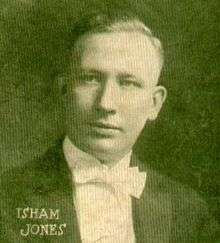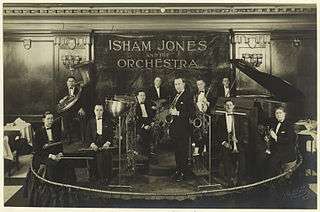Isham Jones
| Isham Jones | |
|---|---|
 Isham Jones, 1922 | |
| Background information | |
| Birth name | Isham Edgar Jones |
| Born |
January 31, 1894 Coalton, Ohio, United States |
| Origin | Saginaw, Michigan |
| Died |
October 19, 1956 (aged 62) Hollywood, Florida, United States |
| Genres | Dance band |
| Occupation(s) | Musician, bandleader, songwriter |
| Instruments | Piano, saxophone |
| Years active | 1911–1938 |
| Labels | Brunswick, Victor, Decca, ARC |
| Associated acts | Woody Herman, Benny Goodman, Walt Yoder, Roy Bargy |
Isham Edgar Jones (January 31, 1894 – October 19, 1956) was an American bandleader, saxophonist, bassist and songwriter.[1]
Career
Jones was born in Coalton, Ohio, to a musical and mining family, and grew up in Saginaw, Michigan, where he started his first band. In 1911 one of Jones's earliest compositions "On the Alamo" was published by Tell Taylor Inc. (Taylor had formed a publishing company the year before when his song "Down by the Old Mill Stream" became a hit.)[2]
In 1915 Jones moved to Chicago, Illinois. He performed at the Green Mill Gardens, then began playing at Fred Mann's Rainbo Gardens.[3] Chicago remained his home until 1932, when he settled in New York City. He also toured England with his orchestra in 1925.[4]

In 1917, he composed the tune "We're In The Army Now" (known as well "You're In the Army Now") when United States entered the World War I. The same tune has been popular well again during the World War II and it's played even by US Army Band.
The Isham Jones band made a series of popular gramophone records for Brunswick throughout the 1920s. His first 26 sides, made at Rainbo Gardens, were credited to "Isham Jones Rainbo Orchestra". By the end of 1920, the name was simply "Isham Jones Orchestra".
He led one of the most popular dance bands in the 1920s and 1930s. His first successful recording, "Wabash Blues" written by Dave Ringle and Fred Meinken, was recorded in 1921 by "Isham Jones and his Orchestra". This million-seller stayed for twelve weeks in the U.S. charts, six at No. 1.[5] It was awarded a gold disc by the RIAA.[6] Noted musicians who played in Jones's band included Louis Panico, Benny Goodman (although no records were made during the short time he was there), Woody Herman, Walt Yoder, and Roy Bargy. Reed virtuoso Al Gallodoro appeared briefly with Jones in 1933, taking part in a record date October 3.[7]
Jones was reportedly a strict taskmaster and was known for being rather cold and distant.
From the start, his Brunswick records were popular. There was a gap from October 1927 to June 1929 where Jones did not record due to disbanding and reorganization.
From 1929 to 1932, his Brunswick recordings became even more sophisticated with offbeat arrangements by Gordon Jenkins and others; Jones was his own arranger early on, but cultivated others. During this period, Jones started featuring violinist Eddie Stone as one of his regular vocalists. Stone had an unusual, almost humorous tone to his voice. His other vocalists included Frank Sylvano, Billy Scott, and Arthur Jarrett. In 1932, he added Joe Martin, another of the band's violinists, as a frequent vocalist. In April that year, young Bing Crosby recorded two sessions with Jones's group which included "Sweet Georgia Brown". Crosby at this point in his career was still singing in a jazz idiom, transitioning to his better known "crooner" style.
In August 1932, Jones signed with Victor, and these records are considered among the best arranged and performed commercial dance band records of the Depression era. Victor's recording technique was suited to Jones' band. In October 1932, he teamed up with the Three X Sisters in New York who had just departed from CBS radio. They recorded "experimental" songs for RCA Victor in which Jones began to fuse jazz and early swing music. They recorded "Where? (I Wonder Where?)" and "What Would Happen to Me If Something Happened to You." His Victor releases had an almost symphonic sound, often with a strong use of tuba. During his Victor period, he recorded two long playing "Program Transcription" records as part of Victor's unsuccessful 33 1/3 RPM series. He stayed with Victor until July 1934, when he signed with Decca. Jones's recordings during this period rivaled Paul Whiteman, Waring's Pennsylvanians, Leo Reisman and other dance orchestras as examples of the most popular dance music of the era.
Jones' Decca recordings are often unfavorably compared to his Victor recordings, due to Decca's recording techniques, Decca's insisting that Jones re-record many of his Victor recordings, and the apparent smaller size of his orchestra. After he left Decca in 1936, he again retired and his orchestra was taken over by band member Woody Herman. Jones started a new band in 1937–38 and recorded a handful of sessions under the ARC labels: Melotone, Perfect and Banner.
In the 1940s, Jones resided on his poultry farm in Colorado, which he occasionally left for short tours with pickup bands. He later resided in Los Angeles. He moved to Hollywood, Florida in 1955, and died there of cancer in 1956.[8] (He is interred at Forest Lawn Memorial Park in Glendale, California, and perhaps for that reason is often erroneously listed as having died in Hollywood, California.)
His great-nephew is jazz drummer Rusty Jones.
Compositions
Isham Jones' compositions (he wrote the music, Charles Newman and Gus Kahn were among his lyricists):
- "We're In The Army Now (You're In The Army Now)" 1917 - Lyrics by Tell Taylor & Ole Olsen
- "You Gave Me Your Heart" Brunswick 2350-A
- "The Sneak!" Brunswick 2350-B
- "Dog on the Piano" Brunswick 2646-A
- "Mahsi" Brunswick 2646-B
- "Meet Me in Bubble Land" 1919
- "On the Alamo" recorded 1922 (composed & published in 1911)
- "Swingin' Down the Lane" 1923
- "I'll See You in My Dreams" 1924
- "The One I Love (Belongs to Somebody Else)" 1924
- "It Had to Be You" 1924
- "Spain" 1924
- "Song of the Blues" (1929)
- "Not a Cloud in the Sky" 1929
- "What's the Use?" 1930
- "Feeling That Way" 1930
- "You're Just a Dream Come True" (his theme song) 1931
- "I Wouldn't Change You For The World" 1931
- "Let That Be a Lesson to You" 1932
- "I Can't Believe It's True" 1932
- "One Little Word Led to Another" 1932
- "The Wooden Soldier and the China Doll" 1932 ["Calvacade of Vitaphone Shorts Volume 1: Swing, Swing Swing:1931-1944" (Cat. #ML103928) 1934]
- "I'll Never Have to Dream Again" 1932
- "Pretending You Care" 1932
- "There's Nothing Left to Do But Say Goodbye" 1932
- "Why Can't This Night Go On Forever?" (another theme song) 1932
- "You've Got Me Crying Again" 1933
- "Honestly" 1933
- "Old Lace" 1933
- "Something Seems to Tell Me" 1933
- "You're Welcome" 1933
- "Bubbles in the Wine" 1933
- "All Mine, Almost" 1934
- "There Is No Greater Love" 1936[9]
Number one hits
During the 1920s, Isham Jones had several number one records on the pop charts in the U.S.:
- "Wabash Blues" – six weeks, 1921
- "On the Alamo" – four weeks, 1922
- "Swinging Down the Lane" – six weeks, 1923
- "Spain" – two weeks, 1924
- "It Had to Be You" – five weeks, 1924
- "I'll See You in My Dreams" – seven weeks, 1925
- "Remember" – one week, 1925
- His 1930 version of "Star Dust" was one of the bestselling versions. Jones commissioned Victor Young to write a ballad instrumental of the mid-tempo tune and it was this arrangement (with Victor Young's violin solo) which became such a hit. Mitchell Parish wrote lyrics for the song at this time.
Discography
- Happy: The 1920 Rainbo Orchestra Sides (Archeophone, 2014)
Honors
- 1989 – Big Band and Jazz Hall of Fame, Songwriters Hall of Fame
- 2005 – "California, Here I Come" inducted into the Grammy Hall of Fame
- 2007 – "It Had to Be You" inducted into the Grammy Hall of Fame
References
- ↑ oxfordindex.oup.com, Grove Music Online
- ↑ allmusic.com
- ↑ CD liner notes: Happy: The 1920 Rainbo Orchestra Sides, 2014 Archeophone Records
- ↑ shellac.org
- ↑ CD liner notes: Chart-Toppers of the Twenties, 1998 ASV Ltd.
- ↑ Murrells, Joseph (1978). The Book of Golden Discs (2nd ed.). London: Barrie and Jenkins Ltd. p. 12. ISBN 0-214-20512-6.
- ↑ jazzbiographies.com
- ↑ songwritershalloffame.org
- ↑ redhotjazz.com
Bibliography
- The Complete Encyclopedia of Popular Music and Jazz 1900–1950. Roger D. Kinkle: Arlington House Publishers, 1974
External links
| Wikimedia Commons has media related to Isham Jones. |
- Isham Jones discography at Discogs
- Isham Jones at Find a Grave
- Biography, photos, audio
- Shellac.org
- Archeophone Records